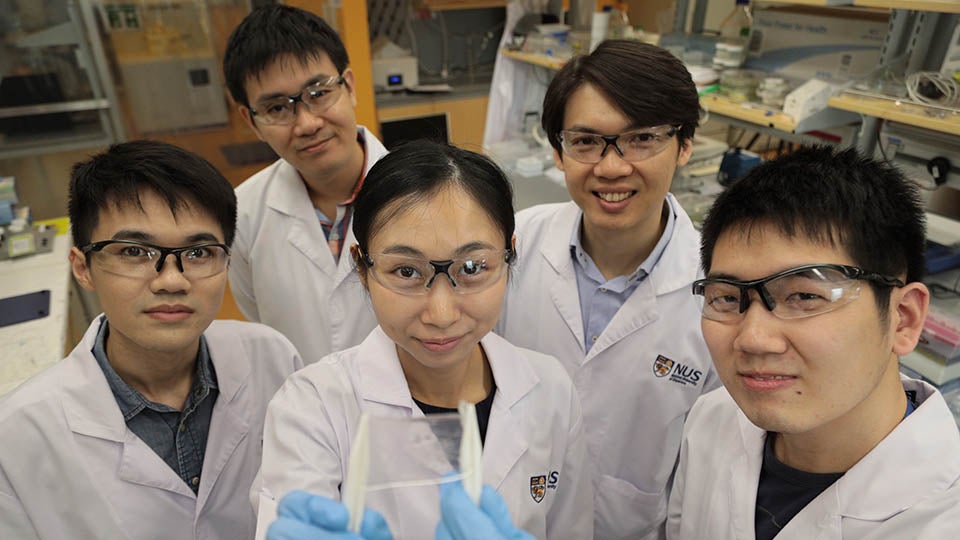
Robotic and prosthetic devices may one day be equipped with a sense of touch equivalent to or better than human skin. A research team at the National University of Singapore (NUS) has developed the Asynchronous Coded Electronic Skin (ACES) system, which can sense touch at 1,000 times the speed of the human nervous system.
As well as being able to detect touch at 1,000 times the speed of the human nervous system, ACES can differentiate physical contact between different sensors in less than 60 nanoseconds. This is the fastest an electronic skin has ever been able to sense touch.
It is also able to accurately identify the shape, texture and hardness of objects within 10 miliseconds.
A sense of connection
ACES is constructed from a network of electronic sensors connected to a single electrical conductor, meaning the skin can continue functioning as long as the sensors and conductors remain connected. Existing electronic skins have used interlinked wiring systems, but this had made them overly sensitive to damage due to all of the separate connections. It has also made electronic skin technologies difficult to scale up, but ACES can be ‘grown’ simply by adding more sensors.
NUS assistant professor Benjamin Tee said: “Scalability is a critical consideration as big pieces of high performing electronic skins are required to cover the relatively large surface areas of robots and prosthetic devices.
“ACES can be easily paired with any kind of sensor skin layers, for example, those designed to sense temperatures and humidity, to create high performance ACES-enabled electronic skin with an exceptional sense of touch that can be used for a wide range of purposes.”
How well do you really know your competitors?
Access the most comprehensive Company Profiles on the market, powered by GlobalData. Save hours of research. Gain competitive edge.

Thank you!
Your download email will arrive shortly
Not ready to buy yet? Download a free sample
We are confident about the unique quality of our Company Profiles. However, we want you to make the most beneficial decision for your business, so we offer a free sample that you can download by submitting the below form
By GlobalDataPairing ACES with the transparent, self-healing and water-resistant sensor skin layer also recently developed by Tee and his team created an electronic skin that can self-repair, just like human skin.
Self-healing skin, whatever the weather
Tee said: “One of the challenges with many self-healing materials today is that they are not transparent and they do not work efficiently when wet. With this idea in mind, we began to look at jellyfishes — they are transparent, and able to sense the wet environment. So, we wondered how we could make an artificial material that could mimic the water-resistant nature of jellyfishes and yet also be touch-sensitive.”
The self-healing skin works by suspending a fluorocarbon-based polymer in a fluorine-rich ionic liquid to create a gel. The polymer network interacts with the ionic liquid via reversible ion-dipole interactions, which allows it to self-heal.
While most conductive polymer gels such as hydrogels would swell when submerged in water or dry out in air, this material can retain its shape in both wet and dry environments.
The material is 3D-printed into soft, stretchable electronic circuits, which allow for the system’s electrical properties to change when touched, pressed or strained.
An accessibility revolution
By accurately mimicking the mechanisms of biological tissue, combining the two different types of skin developed by Tee and his team could lead researchers to develop more realistic prosthetic limbs.
Tee said: “Humans use our sense of touch to accomplish almost every daily task, such as picking up a cup of coffee or making a handshake. Without it, we will even lose our sense of balance when walking. Similarly, robots need to have a sense of touch in order to interact better with humans, but robots today still cannot feel objects very well.”
Other potential applications include developing intelligent robots that can perform disaster recovery tasks or automate operations such as packing items in warehouses. The self-healing skin is even thought to have useful applications within the smart tech field, as it could be used to build water-resistant, self-repairing touchscreens for mobile phones and tablets.


